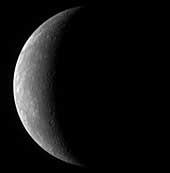|
COMETS EARTH JUPITER KUIPER BELT MARS MERCURY METEORITES NEPTUNE OORT CLOUD PLUTO SATURN SOLAR SYSTEM SPACE SUN URANUS VENUS ORDER PRINTS
PHOTO CATEGORIES SCIENCEVIEWS AMERICAN INDIAN AMPHIBIANS BIRDS BUGS FINE ART FOSSILS THE ISLANDS HISTORICAL PHOTOS MAMMALS OTHER PARKS PLANTS RELIGIOUS REPTILES SCIENCEVIEWS PRINTS
|
Related Documents
Download Options
On January 14, 2008, at 19:04:39 UTC (2:04:39 pm EST), MESSENGER experienced its closest approach to Mercury, passing just 200 kilometers (124 miles) above the planet's surface. As the MESSENGER spacecraft speed toward Mercury, the Narrow Angle Camera, part of the Mercury Dual Imaging System (MDIS) instrument, acquired this crescent view of Mercury. The image was taken on January 13, 2008, when the spacecraft was at a distance of about 760,000 kilometers (470,000 miles) from Mercury. Mercury is about 4880 kilometers (about 3030 miles) in diameter, and this image has a resolution of about 20 kilometers/pixel (12 miles/pixel). During the historic flyby encounter, extensive scientific data is to be gathered. The MDIS instrument will acquire over 1200 images of Mercury, including images of portions of the surface never before viewed by a spacecraft. The MDIS instrument is just one member of a whole suite of instruments that will be used to study Mercury during the flyby. The Mercury Atmospheric and Surface Composition Spectrometer (MASCS) will observe Mercury's surface as well as its tenuous atmosphere. The MESSENGER Magnetometer (MAG) will accurately measure Mercury's magnetic field, and the Energetic Particle and Plasma Spectrometer (EPPS) will characterize Mercury's space environment and interactions with the solar wind. The Mercury Laser Altimeter (MLA) will sense surface topography along a narrow profile. The Gamma-Ray and Neutron Spectrometer (GRNS) and X-Ray Spectrometer (XRS) will make the first measurements of Mercury's surface elemental composition. MESSENGER will begin to transmit the new data to Earth once all of the scientific measurements are completed, about 22 hours after the spacecraft's closest approach to Mercury. These flyby data will shed light on fundamental scientific questions related to the formation and evolution of the planet Mercury. As scientists analyze the data, the MESSENGER spacecraft will continue on its planned journey, which includes two more encounters of Mercury in October 2008 and September 2009, before entering an orbit around Mercury in March 2011. Image acquired on January 13, 2008, 06:34 UTC. |
